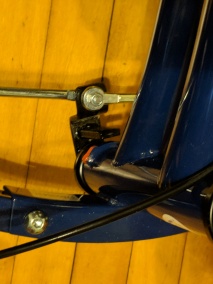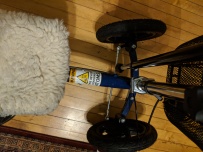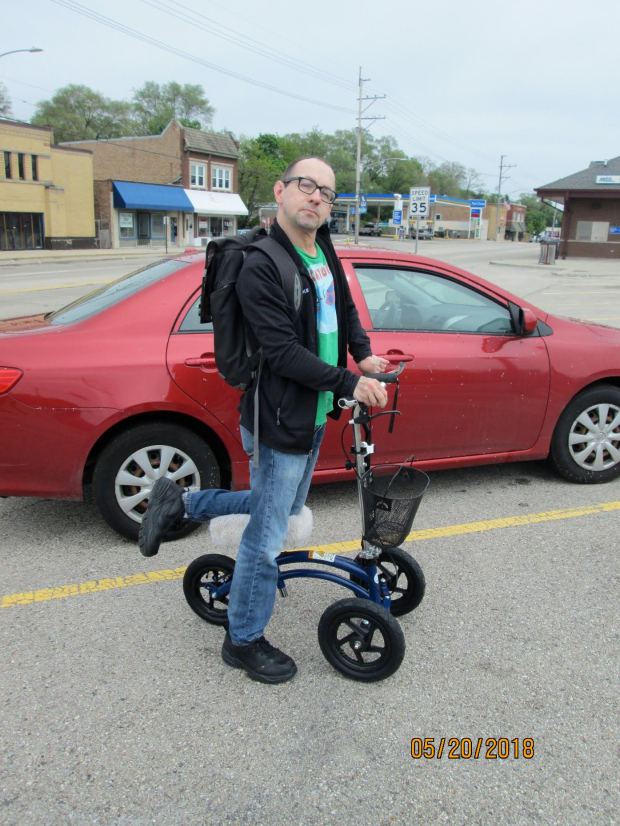I have a friend from the Chicago bike community, Carl Harris, also known as Chopper Carl (I showed him this piece before publication, so I have his approval to use his name). I see him around on occasion, but we’ve fallen out of touch the past few years. We both still connect with the bike community, but neither of us is as active as we were.
Carl is a clown, always cutting up and joking around, modifying bikes in goofy ways and giving them funny names. Back in the day he built a bike trailer with a stereo, and he used to ride at Critical Mass and kick out the jams for all the people. Such a fun guy.
One evening a few years ago we were biking around after Critical Mass, and we went to his place, out on the West Side of Chicago. He wanted to show me some of the stuff he was doing with his computer, adding a hard drive and changing some stuff around. He used it to manage his music collection.
At some point he mentioned he wanted to make some change, I forget what, and I said, ‘I think that’s a BIOS setting.’ And he said, ‘I’m not smart enough to mess around with the BIOS.’ To which I replied, ‘if you’re smart enough to do all the stuff you’ve already showed me, you’re smart enough to mess around with the BIOS.’
That interaction didn’t register with me for a few days. Who the hell says they’re ‘not smart enough’ to do something?
Later that evening, we rode down to my place. We rode past the high school he attended years before, a West Side school. I asked him what it was like. He said he kept his head down and stayed out of trouble.
At this point, I shouldn’t have to mention: Carl is African American. His place was in poor shape. His neighborhood was rough. He was working as a bike mechanic at the time.
And it struck me, as I turned the story of that evening over in my head: Carl was a smart guy. He was like me. And the difference between his path and mine, his opportunities and mine, was not vast, but it was substantial. I grew up in the suburbs of Chicago, got a decent education (largely at taxpayer expense), had a bit of luck, and had a reasonably impressive resume at that point. He grew up on the West Side, and managed to keep his intellectual curiosity alive under adverse circumstances. I don’t know all the details of his story. But I had had better opportunities than he did, and made more of them than he could.
I saw myself. If I had been born in another place, with a different skin color, my brains would not necessarily have gotten me this far.
Now, I don’t want to paint Carl as a victim. These days he’s married, and he preaches the Good Word at a church on the South Side, and he plays the Hammond organ. I see from Facebook he’s gotten into ham radio. He’s still curious, always learning and tinkering.
He’s made a life for himself, and I want to be clear I respect his accomplishments. But he could have had more opportunities to develop his fertile mind and capitalize on his capability. He’s not a dumb guy.
And I realized he wasn’t alone.
Now, I think racial oppression and suffering are awful and unfair. It breaks my heart and makes me sad. But I live every day with pain and I get up and do my thing, and I see lots of African Americans do too.
What’s worse in my mind is the wasted time and potential. There is capability wasted, and there is brilliance unrealized. We are wasting these people’s time.
This was where I started to get angry, on behalf of my friend and others like him. And this is the place I think a lot of white people need to get to.
Race is a bullshit concept. I mean, I’m not trying to erase anyone’s distinctiveness. I respect African American history, heritage, and contribution. But local adaptations humans have developed over time don’t mean anything deep about the potential of the people with those adaptations. It doesn’t stand up to modern biology. And to feel ‘white guilt’ is to accept that logic–that there’s some significance in the color of my skin and yours. ‘I feel bad about what “our people” did to “your people.”‘
No. We need to see through these artificial distinctions. These may be African Americans enduring injustice, but the ones I know are a whole lot more American than they are African, and they deserve the same opportunities everyone else does. We should feel the same indignation and solidarity we would over their oppression we would if they were white. And we need to identify the self-fulfilling prophecies baked into the lie of ‘race,’ and find ways to turn them back.
It’s a platitude to say, ‘inside we’re all the same.’ But if it’s true, what does that mean? It means Freddie Gray was not just a loss to the African American community. He was a loss to the American community. He had a right to live out his little life the same as I do mine, and everyone else does theirs. And just because his skin was darker than mine doesn’t mean I should put his suffering and death and lost potential in a different category than mine.
We will never get to see what Freddie Gray would make of his life. His death is a tragedy and a crime, and I hope justice is served in his case. But you don’t have to kill someone to rob them of years of their life, or what they could make of those years. And African Americans aren’t the only ones who should be angry about that.







